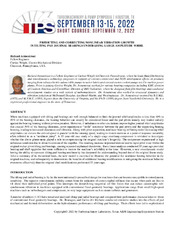| dc.description.abstract | When machines equipped with tilting pad bearings are well enough balanced to limit the journal whirl amplitudes to less than 40% to 50% of the bearing clearance, the bearing behavior can usually be considered linear and the pad pivots usually stay loaded radially against the bearing housing without pivot separation. However, if unbalance or other excitations impose higher journal whirl amplitudes that exceed 50% of the bearing clearance, pivot separation or “rattle� can occur between the pad pivots and the supporting bearing housing, leading to increased clearances and vibration. Along with pivot separation, nonlinear bearing stiffening under increasing whirl amplitudes can elevate the critical speed in parallel with the running speed, leading to violent motions at a point of response instability often referred to as a “nonlinear jump�. A 35-year-old case study of a single-stage overhung compressor is revisited to investigate whether the above phenomena played a role in compromising the original machine’s longevity. The compressor experienced a high unbalance condition due to abrasive erosion of the impeller. The resulting increase in journal motion lead to rapid pivot wear within the original rocker-pivot tilting pad bearings, causing repeated unplanned shutdowns. Basic linear analyses conducted 35 years ago provided bearing and shaft upgrades that were sufficient to restore the machine’s reliability at the time. However, a new rotordynamic model having the ability to represent tilting pad bearing nonlinearity has deepened the understanding beyond that of the original linear study. After a summary of its theoretical basis, the new model is exercised to illustrate the potential for nonlinear bearing behavior in the original machine, and subsequently to demonstrate the benefits of additional bearing modifications in mitigating the nonlinear behavior even more effectively than the original shaft modifications performed 35 years ago | |


